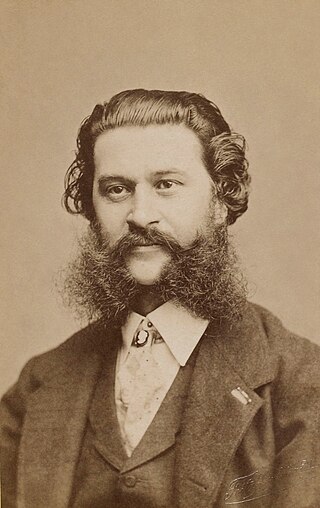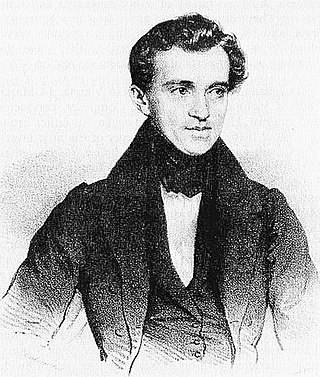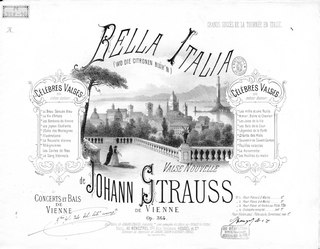
Johann Baptist Strauss II, also known as Johann Strauss Jr., the Younger or the Son, was an Austrian composer of light music, particularly dance music and operettas as well as a violinist. He composed over 500 waltzes, polkas, quadrilles, and other types of dance music, as well as several operettas and a ballet. In his lifetime, he was known as "The Waltz King", and was largely responsible for the popularity of the waltz in Vienna during the 19th century. Some of Johann Strauss's most famous works include "The Blue Danube", "Kaiser-Walzer", "Tales from the Vienna Woods", "Frühlingsstimmen", and the "Tritsch-Tratsch-Polka". Among his operettas, Die Fledermaus and Der Zigeunerbaron are the best known.

Johann Baptist Strauss I, also known as Johann Strauss Sr., the Elder or the Father, was an Austrian composer of the Romantic Period. He was famous for his light music, namely waltzes, polkas, and galops, which he popularized alongside Joseph Lanner, thereby setting the foundations for his sons—Johann, Josef and Eduard—to carry on his musical dynasty. He is best known for his composition of the Radetzky March.

"The Blue Danube" is the common English title of "An der schönen blauen Donau", Op. 314, a waltz by the Austrian composer Johann Strauss II, composed in 1866. Originally performed on 15 February 1867 at a concert of the Wiener Männergesang-Verein, it has been one of the most consistently popular pieces of music in the classical repertoire. Its initial performance was considered only a mild success, however, and Strauss is reputed to have said, "The devil take the waltz, my only regret is for the coda—I wish that had been a success!"
Man lebt nur einmal! is a waltz by Johann Strauss II written in 1855. The piece was marked as im Ländlerstyle which in other words means "in the same style as the Ländler", which is an Austrian folk dance. The title was a quotation from Johann Wolfgang von Goethe's 1774 play Clavigo, but it raised a few eyebrows at that time as Vienna was just recovering from a disastrous cholera epidemic and many of the stricken populace may have been superstitious of such a title. Nonetheless, Strauss performed it at the Sperl Ballroom to great acclaim and this waltz has endured lasting appeal even in a simple string arrangement for a quintet consisting of two violins, one viola, one cello, and a double bass.
"Die Publicisten" is a waltz by Johann Strauss II composed in 1868. It was written for the sixth Concordia Ball held in the Sofienbad-Saal on the 4 February of the same year. The waltz's title was an allusion to Vienna's press, with whom he maintained a fruitful partnership that his family had enjoyed since the days of his father Johann Strauss I. The more or less symbiotic association was needed as the musical business of composers would inevitably flourish under favorable press reviews and the establishment of the Vienna Journalists' and Authors' Association in 1859 would signify an even more closer relationship between both composer and the press. The Concordia Ball named after the Roman God of civic concord had its first ball in 1863.

Rathausball-Tänze op. 438 is a waltz by composer Johann Strauss II written in 1890 in honour of the inauguration of the new city hall of Vienna. At the opening of the new banqueting hall (Festsaal) on 12 February 1890 two rival orchestras were commissioned to provide dance music for the occasion; the Strauss Orchestra under the direction of Eduard Strauss, and that of rival Kapellmeister Karl Michael Ziehrer who was head of the Vienna House Regiment 'Hoch und Deutschmeister No. 4'.
Liebeslieder op. 114 is a waltz by Johann Strauss II written in 1852. At the time it was conceived, the waltz was titled 'Liebesgedichte' or "Love Poems" and during its first performance, it was even announced as 'Liebesständchen' or "Love Serenade". The first performance was at the famed Vienna Volksgarten on 18 June 1852 under the composer's direction.

Kaiser-Walzer, Op. 437 is a waltz composed by Johann Strauss II in 1889. The waltz was originally titled Hand in Hand and was intended as a toast made in August of that year by Emperor of Austria Franz Joseph I on the occasion of his visit to the German Emperor Wilhelm II where it was symbolic as a 'toast of friendship' extended by Austria-Hungary to the German Empire.
Künstlerleben, Op. 316 is a waltz written by Johann Strauss II in 1867, following closely on the success of the popular "The Blue Danube". Austria was severely shaken the previous year 1866 by the crushing defeat that the Austrian army suffered in the Battle of Königgrätz and many of the year's festivities and balls were cancelled as the prevalent depressing mood affected most of Vienna's populace.
Bürgersinn op. 295 is a waltz by Johann Strauss II composed in 1865 for the Citizen's Ball held during the Vienna Carnival Fasching of the year. His prestigious post of the 'KK Hofballmusikdirektor', which he attained in 1863, meant that his responsibilities included composing dance music for these functions.

Wiener Blut Op. 354 is a waltz by Johann Strauss II first performed by the composer on 22 April 1873. The new dedication waltz was to celebrate the wedding of the Emperor Franz Joseph I's daughter Archduchess Gisela Louise Maria and Prince Leopold of Bavaria. However, the waltz was also chiefly noted by Strauss' biographers as the début of Strauss with the Vienna Philharmonic Orchestra where for many years, the Philharmonic had dismissed any association with the 'Waltz King' as it had not wished to be associated with mere 'light' or 'pops' music. The festival ball celebrating the event was held at the Musikverein Hall which is the venue for the present day Neujahrskonzert.
Karnevalsbotschafter op. 270 is a waltz composed by Johann Strauss II in the autumn of 1862 during his honeymoon with his first wife Henrietta Treffz in Venice. It was first performed at the 50th anniversary celebration of the Vienna's Gesellschaft der Musikfreunde at the 'Sperl' dance hall on 11 November 1862.
Schatz-Walzer, Op. 418, is a Viennese waltz by Johann Strauss II composed in 1885. The melodies in this waltz were drawn from Strauss' operetta Der Zigeunerbaron, which premiered to critical acclaim on 24 October 1885. Der Zigeunerbaron, a Hungarian-influenced work, remained Strauss' best-remembered operetta after Die Fledermaus. The waltz version was first performed on 22 November that year in the concert hall of the Vienna Musikverein, with Eduard Strauss conducting.
Flugschriften ('Pamphlets') op. 300 is a waltz by Johann Strauss II written in 1865 and first performed on 17 January 1866 at the Habsburg Court Ball in the Rittersaal of the Imperial Hofburg Palace graced by the Emperor Franz Josef and Empress Elisabeth. The waltz had earlier been intended to be dedicated for the occasion of the annual ball of the Vienna Authors' and Journalists' Association 'Concordia' ball held at the Sofienbad-saal ballroom on 21 January 1866.

"Wo die Zitronen blühen", Op. 364, is a waltz by Johann Strauss II written in 1874. The waltz was composed during a tour of the composer in Italy where he travelled with the Langenbach Orchestra of Germany and performed the work at the Teatro Regio in Turin on 9 May 1874.
Leitartikel op. 273 is a waltz composed by Johann Strauss II in 1863 and first performed at the Vienna's Artists and Journalists' Association ball called 'Concordia', which glorifies the Roman goddess of civic harmony, on 19 January 1863. Theoretically, this work would have been Strauss' only contribution towards the festivity of Vienna's Fasching of that year as his health did not permit laborious hours of conducting nor of composing.
"Tales from the Vienna Woods" is a waltz by Johann Strauss II.
Vienna Waltzes is a ballet choreographed by George Balanchine to music by Johann Strauss II, Franz Lehár and Richard Strauss, made as a tribute to Austria. It premiered on June 23, 1977 at the New York State Theater, performed by the New York City Ballet, and was an immediate success among the public.
Idyllen (Idylls), Op. 95, is a waltz composed by Johann Strauss II in 1851. It was composed for a "Grand Summer Festival Soiree" in the Vienna Volksgarten, with the composer conducting the Strauss Orchestra in its first performance. The fifth waltz melody of the work incorporates themes from the popular song O Madchen mein unter'm Hollerstock. The Theater Zeitung commented on the Strauss waltz that "it is most original and displays a multitude of piquant dance rhythms which are instrumented with much spirit and, amidst tumultuous applause from the select and numerous public, had to be played da capo."
Promotionen (Graduations), Op. 221, is the name of a waltz composed by Johann Strauss II. It was dedicated to the law students at Vienna University, and was first performed under the title of Die Präparanden, a term referring to students who are preparing for their final examinations. The waltz was not very successful when first performed in the Sofienbad-Saal on February 8, 1859: the Fremden-Blatt, although praising the execution of the waltz, said that it "lacked the rhythm and melody of older Strauss compositions." However, a reviewer for the Wiener Allgemeine Theaterzeitung was less critical of the composition, commenting that "in particular the first, third and fifth [waltz sections] are rich in fresh and attractive melodies [...] through this composition Strauss has lately demonstrated that he still has at his disposal a profusion of piquant and original melodies."






